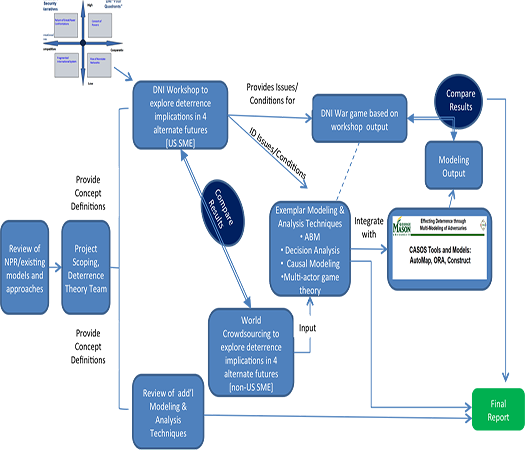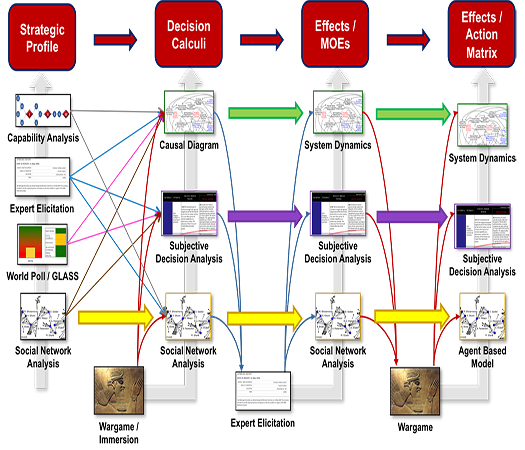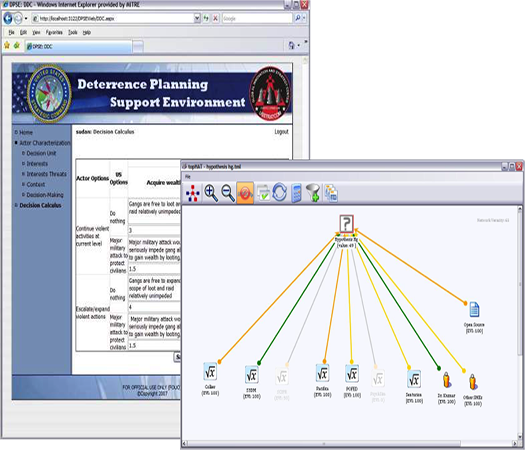STATE AND NON-STATE DETERRENCE
NSI has conducted a variety of research and analyses focused on state and non-state deterrence. Our efforts range from capturing concepts and analyses of nuclear strategy; developing intellectual frameworks identifying how various kinds of models, methods, and techniques work together to help analysts understand deterrence, non-proliferation, and assurance-related issues; developing a strategic deterrence decision analysis framework for 21st century state and non-state threats; and designing and developing a deterrence planning support environment (DPSE) web-based software system.

Concepts and Analyses of Nuclear Strategy
NSI led an effort to capture concepts and analyses of nuclear strategy requested by US Strategic Command (STRATCOM). The purpose for the project was to examine relevant concepts and utility of alternative analytic techniques for assessing the sufficient nuclear force structure and posture to provide stable deterrence, assurance, defeat, and proliferation security as the US progresses toward a reduced force size. NSI provided overall technical design and management, tasking and management of an academic consortium, modeling development (agent-based model, decision analysis, lab experimentation), report writing, and meeting minutes production for the duration of the project. NSI developed an intellectual framework identifying how various kinds of models, methods, and techniques work together to help analysts understand deterrence, non-proliferation, and assurance-related issues. NSI also developed two prototype decision analysis tools to support a deterrence problem, namely, the Decision Analysis Tool (DAT) and the Attributes Trade-off Model (ATOM). The DAT tested the sensitivity of assessed actors’ preferred options to decision making heuristics and risk-propensities, while the ATOM analysed trade-offs between force posture attributes, US policy objectives, costs and risk, and impact of posture changes on each.

Strategic Deterrence Planning
NSI provided STRATCOM with a strategic deterrence decision analysis framework for 21st century state and non-state threats. We explored the utility of various deterrence models and simulation methods, determined how wargaming can contribute to an understanding of adversary decision-making and add value to existing deterrence products, and assessed the applicability of different models to improve the analytic foundation of strategic deterrence planning. We also explored how modeling and simulation, triangulation and iteration of multiple methods, and wargaming can complement one another and generate new (combined) insights as well as improve rigor and thereby reduce uncertainty and risk and increase confidence to ultimately enhance deterrence assessments and analysis. In a related effort, NSI participated in an inter-agency limited objective experiment that focused on evaluating state-of-the-art modeling and analysis tools to help analysts anticipate rare events. As part of this effort we measured and demonstrated the value of collaborative processes, and assessed the value of collaborative processes, tools and environments, and network architectures to find and characterize leading indicators of rare events.

Deterring State and Non-State Adversaries
NSI participated in an effort for US STRATCOM to aid deterrence planners and analysts in identifying the information about an adversary, whether state or non-state, needed to produce “greatest confidence” options for deterring the adversary from acting in contravention to US national interests. The USG has evolved from a deterrence theory based on Mutual Assured Destruction to requiring a more agile and tailored deterrence approach based on specific adversaries for given situations. Since the end of the Cold War, adversaries have become an assortment of nation states, non-nation states, and transnational terrorist organizations. These adversaries have widely differing and complex perceptions of the relationship between their actions and those of the United States. There were three key complementary phases for this effort: we defined a taxonomy and typology to characterize actualized elements needed to understand and ways to influence a specific adversary’s decision calculus; we participated in a series of seminars to evaluate the framework of understanding necessary to deter an adversary; and we reviewed and assessed how commercial and corporate entities deter competitors in their respective markets. NSI developed a strategic decision analysis framework with the objective to decisively influence an adversary’s strategic decisions by shaping his perception of benefits and costs of hostile action and his perception of the costs and benefits of inaction. Our efforts also focused on developing methods for STRATCOM and its partners to sufficiently understand a specific adversary’s decision calculus and employ a rigorous, well-defined, yet tailorable, approach to identify potential deterrent actions and understand the potential impacts of those actions for both state and non-state actors.

Deterrence Planning Support Environment
NSI also designed and supported the development of a 5-step deterrence planning support environment (DPSE) web-based software system comprised of the following five steps: 1. specify deterrence objective and strategic context including guidance typology and identify actors, context typology for each actor, and decision unit typology for each actor; 2. assess decision calculus of actor decision maker including interests typology for each actor; 3. identify desired deterrence effects on actor decision calculus including Deterrence Decision Calculus (DDC) matrix for each actor; 4. identify hypotheses; and 5. validate hypotheses using models, SMEs, and other sources.